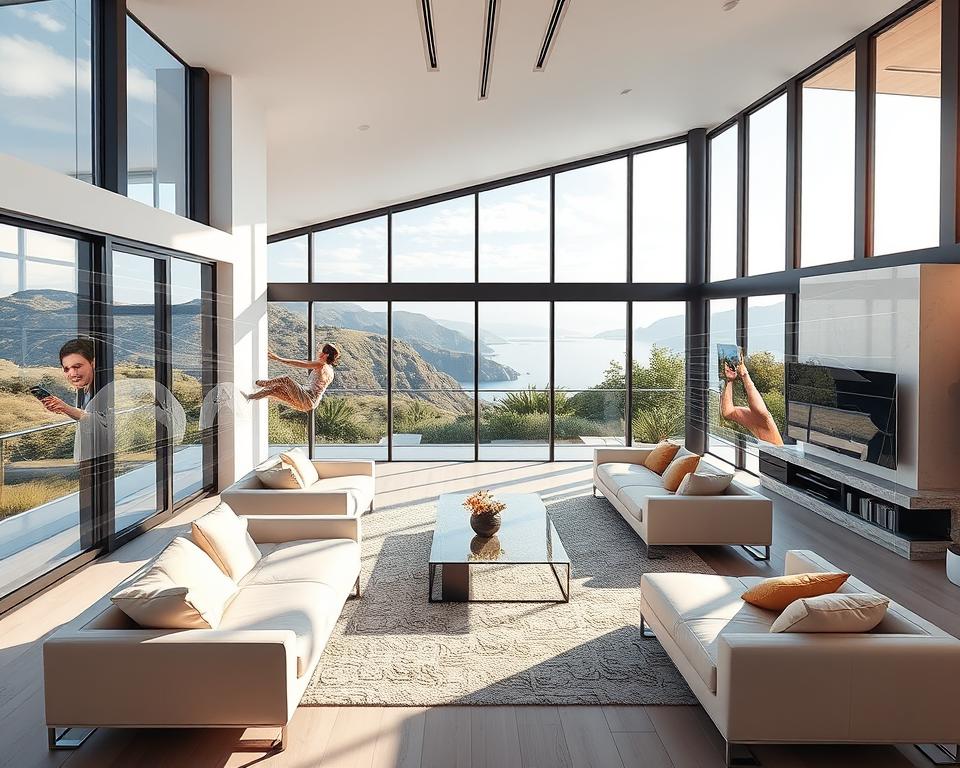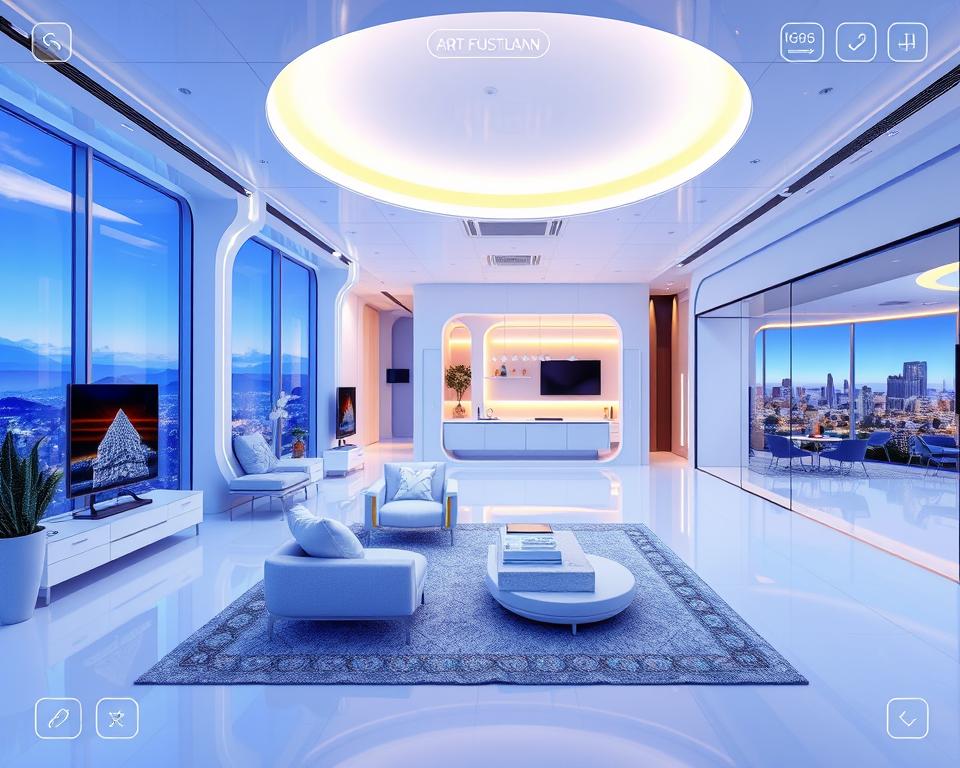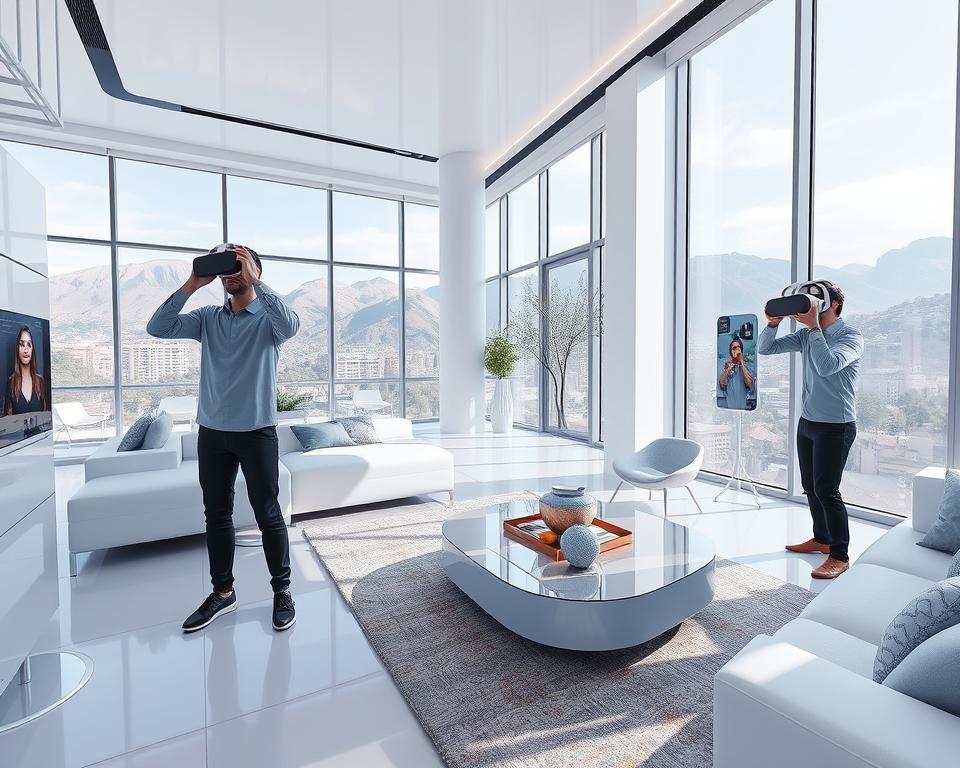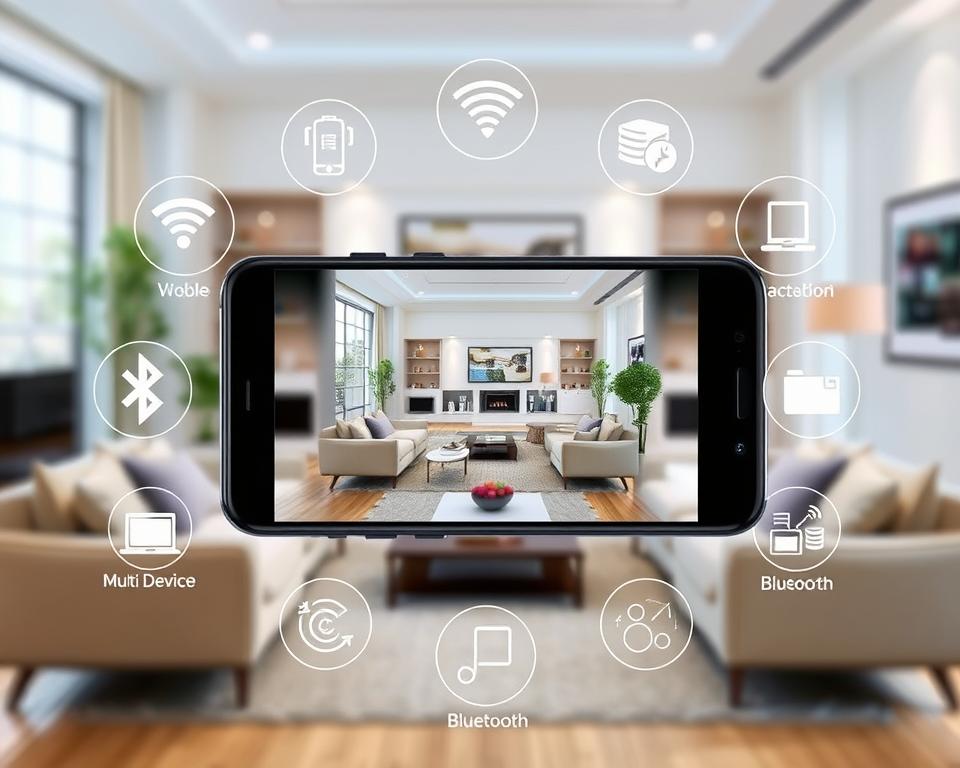In today’s fast-changing real estate world, virtual property tours are key for everyone involved. Companies like Matterport have led the way, changing how we see and show properties. If you want to create a virtual property tour app like Matterport, this guide will help you get started.
The virtual property tour market has grown a lot lately. This growth comes from more people wanting to see homes online and the use of new real estate tech. Knowing the market, the big players, and how virtual tours affect sales can help your app succeed.
Table of Contents
Key Takeaways
- Understand the current market size and growth projections for virtual property tours.
- Identify the key players in the virtual tour software industry and their competitive landscape.
- Recognize the impact of virtual tours on real estate sales and customer experiences.
- Explore the essential features of modern virtual property tour applications.
- Develop a comprehensive understanding of the technical requirements and development stack for building a virtual property tour app.
Understanding Virtual Property Tour Technology and Market Demand
In the fast-changing world of real estate tech, virtual property tours are making a big splash. They’re changing how buyers and sellers see properties. The market for virtual tours is growing fast, thanks to 3D tour software and the desire for deep property views.
Current Market Size and Growth Projections
The virtual tour market is set to grow a lot. It’s expected to jump from $2.34 billion in 2022 to $5.86 billion by 2027. This is a 20.2% annual growth rate. It’s all because more people want virtual and augmented reality in real estate, and real estate technology trends are catching on.
Key Players in Virtual Tour Software Industry
The virtual tour software world is filled with creative companies. Each one offers something special for the real estate market. Some big names include:
- Matterport: They lead with 3D capture tech and virtual tours, offering AI-powered experiences.
- Zillow 3D Home: It’s part of Zillow, making virtual tours easy for property listings.
- RealVision: They focus on top-notch, interactive tours with cool features like floor plans.
- Kuula: This platform lets you make and share 360-degree tours in many fields, including real estate.
Impact of Virtual Tours on Real Estate Sales
Virtual tours have changed real estate sales a lot. They make listings more engaging online. Buyers spend more time looking at digital tours. This also means properties sell faster and for more money. Virtual tours give buyers a detailed look before they visit in person.
Essential Features of Modern Virtual Property Tour Applications
The demand for virtual property tours is growing fast. Real estate pros and tech providers are always coming up with new ways to make these tours better. The top features of a great virtual tour features app include:
- 3D Walkthrough: This feature lets buyers see the property in a super realistic way. They can explore every part of the property, getting a real feel for the layout and size.
- Property Measurement Tools: These tools help users measure rooms, windows, and other parts of the property. It makes it easier for them to picture the space.
- Hotspot Annotations: These are special points in the tour that highlight important features. They give extra info and make the tour more helpful and fun.
- High-Quality Imagery: Using top-notch images in the tour makes it look just like the real thing. It builds trust and gets buyers excited about the property.
These features make the tour better for users and help real estate agents show off properties in the best way. It leads to more people getting involved and more sales.
| Feature | Description | Benefit |
|---|---|---|
| 3D Walkthrough | Immersive, interactive 3D exploration of the property | Allows prospective buyers to get a true sense of the property’s layout and dimensions |
| Property Measurement Tools | Precise measurement of rooms, windows, and other architectural elements | Enables users to visualize the space more effectively and understand the property’s scale |
| Hotspot Annotations | Strategic placement of informative hotspots throughout the virtual tour | Provides additional details and creates a more guided, engaging experience for users |
| High-Quality Imagery | Rendering the virtual tour with detailed, high-resolution images | Ensures an accurate visual representation of the property, building trust and excitement |
By adding these key features, virtual property tour apps can give buyers a deep and valuable experience. This leads to more successful real estate deals.
“The virtual tour experience has become a game-changer in the real estate industry, allowing buyers to explore properties from the comfort of their own homes and make more informed decisions.”
Technical Requirements and Development Stack Selection
Building a virtual property tour app requires careful planning. You need to pick the right programming languages, frameworks, and databases. This choice can make your app scalable and robust.
Recommended Programming Languages
The programming languages you choose depend on performance, compatibility, and developer skills. Here are some top picks:
- JavaScript – great for both front-end and back-end, perfect for web-based apps.
- Python – powerful for data processing, machine learning, and computer vision, key for 3D scanning.
- C++ – high-performance for native mobile apps and game engines, offering system resource control.
Framework Options and Architecture Choices
The framework you pick affects development, code maintenance, and app performance. Here are some top choices:
- React – a JavaScript library for building interfaces, known for its component-based architecture and efficient rendering.
- Unity – a game engine for creating interactive 3D experiences, including virtual tours, with robust tools and cross-platform capabilities.
- Flutter – a cross-platform framework by Google, allowing for native-looking mobile apps from a single codebase.
Database and Storage Solutions
Virtual tour apps handle large 3D data. You’ll need scalable databases and storage solutions. Here are some options:
| Database Solution | Key Features |
|---|---|
| MongoDB | A NoSQL database great for storing and querying unstructured 3D data, with geospatial query support. |
| Amazon S3 | A cloud-based service for storing and retrieving large 3D assets, offering scalability and high availability. |
| Google Cloud Storage | Another cloud storage option for durable and highly available 3D data storage, integrated with Google’s cloud services. |
Choosing the right app development stack, programming languages, and database solutions is key. This ensures your virtual tour app is scalable, performs well, and offers an immersive experience.
Setting Up the Development Environment
Creating a virtual property tour app needs a strong development setup. You’ll need the right integrated development environment (IDE), version control system, and tools for 3D and image work. A well-organized setup helps you work better and make your virtual tour a reality.
Choosing the Ideal IDE
Picking the right IDE is key to working efficiently. Options like Visual Studio Code, IntelliJ IDEA, and Android Studio have different features. Think about language support, editing tools, and debugging when choosing.
Mastering Version Control
Good version control is vital for your app’s growth. Git is a top choice, known for its branching and merging. Use platforms like GitHub, GitLab, or Bitbucket for easy tracking and teamwork.
Integrating 3D and Image Tools
For a virtual tour app, you need special 3D and image tools. Learn about Unity, Unreal Engine, or Blender for 3D work. Also, get familiar with Adobe Photoshop or GIMP for image editing.
With a solid development environment, you’re ready to build your virtual tour app. The right IDE, version control, and 3D and image tools make your work smoother. This way, you can turn your virtual tour idea into a real app.
How to Build a Virtual Property Tour App Like Matterport
To create a virtual property tour app like Matterport, you need a detailed plan. You must focus on the app’s core features, design a user-friendly interface, and build a strong backend. Each step is important for a successful app.
Core Functionality Implementation
The base of a virtual property tour app is its core features. These include 3D scanning, high-quality image capture, and stitching panoramic views. You also need to add easy navigation, hotspots, and virtual space measurement tools for a great user experience.
User Interface Design Principles
The design of a virtual tour app’s user interface is key to its success. It should follow best practices like easy navigation and clean layouts. Using responsive design and visual consistency ensures the app works well on all devices and appeals to different users.
Backend Infrastructure Setup
A strong backend is vital for the app’s core features and design. You need to choose the right programming languages and frameworks. Also, secure databases and storage solutions are crucial. Planning these components well ensures the app is scalable, fast, and reliable.
By focusing on these areas, you can make a virtual property tour app as good as Matterport. This detailed approach will give you a feature-rich, easy-to-use app that will attract and engage your audience.
Implementing 3D Scanning and Image Processing Features
3D scanning and image processing are key in virtual property tour apps. They make it possible to create accurate and immersive 3D models. This gives users a real-life feel when they explore virtual properties.
3D scanning technology captures the details and dimensions of physical spaces. Photogrammetry is a technique that uses 2D images to make 3D models. Advanced image processing algorithms help create digital models that look like the real thing.
Depth-sensing cameras are also used in 3D scanning. They measure the distance between the device and objects. This information, combined with 2D images, makes detailed 3D models for virtual tours.
These features improve the look of virtual tours and add interactive options. Users can move around, measure rooms, and explore specific areas with great detail.
Using these technologies, virtual property tour apps offer a deep and engaging experience. This can lead to more user interaction and higher sales.
Creating Interactive Virtual Walkthrough Capabilities
Creating a great virtual property tour is more than just 3D pictures. It’s about making the tour interactive. This lets users explore the space easily and get extra info with just a tap. This is where virtual walkthroughs really come alive.
Navigation System Development
The heart of a great virtual tour is its navigation system. It lets users move around the property smoothly. A good navigation system is key, making it easy to move from one area to another.
Using virtual reality (VR) can make the tour even better. It gives a more real and fun way to explore the property.
Hotspot Implementation
Interactive hotspots in the tour can make it even better. They let users get extra info, watch videos, or use special tools. These hotspots can highlight important features, give detailed room info, or even help measure rooms.
Virtual Space Measurement Tools
Adding tools to measure virtual spaces can change the game. They let users see how big rooms are. This helps buyers decide if the space fits their needs.
By mixing these interactive features, developers can make a tour that really grabs attention. It informs and excites potential buyers.
Developing Mobile Device Compatibility
In today’s world, mobile devices are everywhere. Making virtual property tour apps that work on mobile is key. Mobile compatibility, responsive design, and cross-platform development are essential for a great app.
Getting your app to work well on mobile means users have a smooth experience. With responsive design, your app adjusts to fit any screen. This makes it work well on phones, tablets, and more.
To make an app that works on many platforms, you need to think about different devices and users. Using tools like React Native or Flutter can help. They make it easier to make an app that works on both iOS and Android.
| Feature | Importance for Mobile Compatibility |
|---|---|
| Responsive Design | Ensures optimal rendering and user experience on various screen sizes and device orientations. |
| Gesture-based Interactions | Enables intuitive navigation and control of the virtual tour using touch-based gestures. |
| Optimized 3D Asset Loading | Reduces loading times and ensures smooth performance on mobile devices with varying hardware capabilities. |
| Offline Capabilities | Allows users to access and explore virtual tours even in areas with limited or no internet connectivity. |
By focusing on mobile compatibility, responsive design, and cross-platform development, you can make a top-notch virtual property tour app. It will work well on all devices, giving users a great experience.
Integration of Cloud Storage and Data Management
Virtual property tour apps are getting more popular. It’s key to have secure cloud storage and good data management. Cloud storage helps store and manage lots of data, like 3D scans and interactive tours.
Security Protocols Implementation
Keeping user data safe is very important. App developers need strong security to protect data. They use encryption, multi-factor authentication, and access controls to prevent hacking.
Data Backup Solutions
- Having good data management is key to keep data safe. This means using secure cloud storage backups. This way, data can be restored if something goes wrong.
- Regular backups, both on-site and off-site, add extra protection. They make sure users’ data is always there, even when things go wrong.
By using strong cloud storage and data management, app developers can offer a safe and smooth experience. They also protect the important data that makes their apps work.
Building User Authentication and Access Control
Creating a strong virtual property tour app needs careful focus on user authentication and access control. These elements boost data security and offer users experiences that fit their needs. As you start making your virtual tour app, we’ll explore the key parts of user authentication and access control.
User authentication is key to keeping data safe and secure. Your app should have various ways to log in, from passwords to biometrics like fingerprints or facial scans. Strong user authentication ensures only the right people can see the virtual tour data, protecting important property info.
Along with user authentication, access control is important for managing who can do what. Use a role-based access control (RBAC) system, where users get roles with specific rights. This lets you customize the virtual tour for different users, like real estate agents or property owners.
| Authentication Method | Advantages |
|---|---|
| Password-based | Familiar, widely adopted |
| Biometric (fingerprint, facial recognition) | Highly secure, convenient for users |
| Two-factor authentication | Adds an extra layer of security |
By balancing user authentication and access control well, you can make a virtual tour app that keeps data safe and gives users unique experiences. This builds trust and loyalty with your users.
“Implementing robust user authentication and access control is crucial for building a virtual tour app that instills trust and confidence in your users.”
Implementing Analytics and Reporting Features
In the fast-paced world of virtual property tours, data is key. It unlocks huge value for real estate pros and property owners. By implementing strong analytics and reporting features, virtual tour apps help users understand their audience better. They also see how well their digital assets perform.
User Behavior Tracking
Tracking user behavior is vital for any good analytics setup. Virtual tour apps gather lots of data, like:
- Time spent in each virtual space
- Navigational patterns and hotspot interactions
- Device usage and platform preferences
- Engagement metrics such as views, shares, and downloads
This detailed data lets property owners tweak their virtual tours. They can make the experience better and spot areas to get better.
Performance Metrics Dashboard
A good performance metrics dashboard is a key tool. It’s a central place for all important data. It should show key metrics, like:
| Metric | Description |
|---|---|
| Tour Conversion Rate | The percentage of visitors who engage with the virtual tour and convert to leads or inquiries. |
| Average Tour Duration | The average time users spend navigating the virtual tour, indicating their level of engagement. |
| Bounce Rate | The percentage of users who leave the virtual tour without further interaction, potentially highlighting areas for improvement. |
| Lead Generation | The number of leads or inquiries generated through the virtual tour, a crucial metric for measuring the marketing impact. |
By using these performance metrics, property owners and real estate agents can make smart choices. They can improve their virtual tours and get real business results.
Testing and Quality Assurance Procedures
Creating a top-notch virtual tour app like Matterport needs a detailed testing and quality assurance (QA) process. This makes sure the app works well, is easy to use, and performs as expected. Let’s look at the main testing methods and QA steps needed for a great virtual tour app.
First, app testing is key to finding and fixing any problems or bugs before the app is released. This includes unit testing to check each part works right, integration testing to make sure parts work together well, and user acceptance testing to see if the app meets user needs.
- Unit testing: Checking if each app part works as it should.
- Integration testing: Making sure different app parts work together smoothly.
- User acceptance testing: Getting users to check if the app is easy to use and meets their needs.
Along with thorough testing, a strong quality assurance process is vital for keeping the app stable and reliable. This means using a detailed bug tracking system to find, document, and fix any problems that come up during development and testing.
| Testing Methodology | Purpose | Key Objectives |
|---|---|---|
| Unit Testing | Verify individual components | Ensure functionality, logic, and error handling |
| Integration Testing | Evaluate component interactions | Identify integration-related issues and ensure seamless communication |
| User Acceptance Testing | Validate user requirements | Assess usability, accessibility, and overall user experience |
By using a detailed quality assurance plan, you can make sure your virtual tour app works as it should. It will also give users a smooth and enjoyable experience.
Deployment and Launch Strategy
As your virtual property tour app nears completion, it’s time to focus on deployment and launch. A smooth app deployment and performance optimization are crucial. They ensure your users have a seamless and engaging experience.
Server Configuration
Proper server configuration is key for a successful app deployment. Here are steps to set up your server infrastructure:
- Choose a reliable cloud platform or hosting provider that can handle your app’s traffic and data.
- Configure your server’s operating system, web server software, and dependencies for optimal performance and security.
- Implement load-balancing and scalability to handle user demand and future growth.
- Secure your server by configuring firewalls, using SSL/TLS encryption, and regularly updating software to prevent security vulnerabilities.
Performance Optimization
To ensure a high-performing app, focus on these performance optimization techniques:
- Asset Optimization: Compress and optimize media files like 3D scans, images, and videos to reduce sizes and improve loading times.
- Caching and Content Delivery Network (CDN): Use caching and a CDN to deliver static content quickly to users, no matter where they are.
- Asynchronous Loading: Load non-critical resources asynchronously to keep the app responsive, even during high traffic.
- Continuous Monitoring and Scaling: Monitor your app’s performance and user behavior, and scale your infrastructure as needed to maintain performance.
By following these strategies, you can ensure a successful app launch. This will give your users a seamless and engaging experience.
| Key Metric | Target Value |
|---|---|
| Page Load Time | |
| Server Response Time | |
| Concurrent User Sessions | > 1,000 |
Conclusion
The world of virtual tour app development has changed a lot. This change is thanks to the growing need for new real estate tech. Matterport is a top name in this area, showing how virtual tours can change home marketing and sales.
Knowing how to make a virtual tour app like Matterport is key. Businesses and developers can now make their own top-notch apps. These apps meet the real estate industry’s changing needs. They offer cool features like 3D scanning, interactive tours, and advanced data management.
The real estate market is always changing, and virtual tour apps are becoming more important. By using the tips from this article, you can make your app a game-changer. It will help real estate pros and homebuyers work more efficiently and easily. Get ready for the future of virtual property tours and the exciting world of virtual tour app development and real estate technology innovation.



















